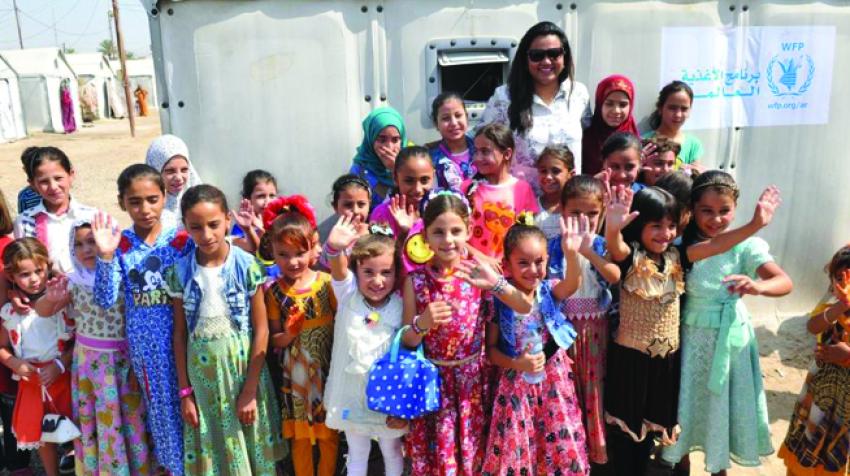January 2018, No. 4 Vol. LIV 2017, Global Citizenship
Today our world is home to the largest youth population ever in history. There are currently 1.8 billion people around the globe between the ages of 10 and 24 and this number is expected to grow. Over the next 13 years, almost 2 billion young people will become part of the world’s youth cohort. In most developing countries, children and adolescents already make up the majority of the population.
This demographic dividend represents the most valuable force that we have to shape a better world for all and gives us an unmatched opportunity to fast-track progress on the Sustainable Development Goals (SDGs). Given their sheer numbers, engaging the world’s 1.8 billion young people will be critical to building the sustainable planet we want. After all, every young person’s life will be shaped by our success in achieving the SDGs.
But far from only building a better future with more opportunities for all, young people are already leading change in the world today, advancing sustainable development and opening pathways to new possibilities for engagement and connectivity around the globe.
Our young generation is not only the largest, but also the most connected in history. Worldwide, youth are nearly twice as networked online as the greater population. In developed countries, young people’s use of the Internet is nearly universal, and in the least developed countries they are three times more likely than the general population to go online. As the most connected generation ever, they are uniquely placed to mobilize their collective strength to achieve the SDGs, to establish dialogue and build partnerships across countries and all sectors of social life—from politics to business, academia and civil society.
In bringing people together from different backgrounds, the Internet and social media are becoming instrumental thanks to the opportunities for connectivity and reach that they enable. Since youth are at the forefront of the use of technology, they are the best equipped generation and our best asset to lead this task and promote global citizenship around the world.
In the online sphere, young people are also the age group that uses social media most frequently. Overall, they are more likely to be social networkers than people aged 35 and older. This age gap is seen both in developing and developed countries alike. For example, 79 per cent of young Internet users in Germany use social media, while only 39 per cent of older users in the country do so. The difference between younger and older users is similar in other countries such as Viet Nam (86 per cent compared to 49 per cent) and Japan (78 per cent compared to 43 per cent).
On average, over 80 per cent of young Internet users are active across social media. Analyses suggest that two of the main reasons why youth go on social media platforms are to network with others and to meet new people, which puts youth in a unique position to engage with people from diverse backgrounds and countries.
Besides networking with their peers, youth have also increased opportunities to connect with national and world leaders on the Internet and social media in particular, and actively participate in conversations with government representatives and policymakers. This is an important step forward in ensuring that young people are involved in decision-making processes. Even though we have the largest and most connected youth generation in history, it is unfortunate that 73 per cent of countries still restrict young people from running for houses of parliament. People under 30 years of age make up less than 2 per cent of the world’s parliamentarians.
In a world that is heavily networked through online platforms, youth are taking the lead in creating mechanisms to hold governments accountable. Through social media, it is becoming increasingly easy to report on governments’ progress on achieving the SDGs and building a better society for all. This can also help us track data and uncover stories that could otherwise be missed in the national reports.
Holding governments accountable through social media is an important mechanism that enables young people to get involved in decision-making processes and is one of the many youth-led initiatives that exist around the world.
As the United Nations Secretary-General’s Envoy on Youth, I have had an opportunity to learn first-hand about great initiatives and projects across all fields that young people are carrying out to make a difference both in their local communities and at a global level, as well as advancing sustainable development. Whether these efforts are aimed at ending poverty, combating climate change, reducing inequalities or promoting entrepreneurship, the Internet and social media have provided young people with the opportunity to showcase these projects on a scale that would have been hard to imagine in the pre-Internet era.
However, we should not forget that technology, even if very useful and often instrumental, is only a tool that enhances the initiative and potential of young people. Demographic and development realities make young people the generation of our time, one that has unyielding energy, produces new ideas and possesses refreshing optimism.
Today, youth are shaping the economic and social futures of their respective countries, changing the world and working hard to promote global citizenship and more connected societies. For this reason, it is crucial that their potential does not go unnoticed. As I always say, there is no better investment than in the capacities and potentials of young people—and there is no better fight than the struggle for the world we want.
The UN Chronicle is not an official record. It is privileged to host senior United Nations officials as well as distinguished contributors from outside the United Nations system whose views are not necessarily those of the United Nations. Similarly, the boundaries and names shown, and the designations used, in maps or articles do not necessarily imply endorsement or acceptance by the United Nations.




